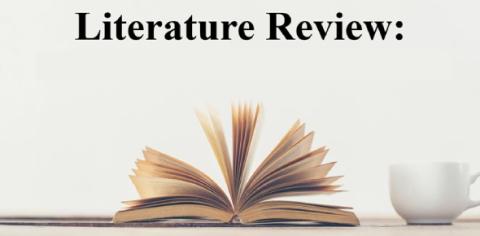How to review the literature in research p.2

Reviewing the selected literature
Now that you have identified several books and articles as useful, the next step is to start reading them critically to pull together themes and issues that are of relevance to your study. Unless you have a theoretical framework of themes in mind to start with, use separate sheets of paper for each theme or issue you identify as you go through selected books and articles. The following example details the process.
The author recently examined, as part of an evaluation study, the extent of practice of the concept of ‘community responsiveness’ in the delivery of health services in Western Australia by health service providers. Before evaluating the extent of its use, pertinent literature relating to ‘community responsiveness in health’ was identified and reviewed. Through this review, many themes emerged, which became the basis of developing the theoretical framework for the study. Out of all of this, the following themes were selected to construct the theoretical framework for the evaluation study:
- Community responsiveness: what does it mean?
- Philosophies underpinning community responsiveness.
- Historical development of the concept in Australia.
- The extent of use in health planning?
- Strategies developed to achieve community responsiveness.
- Indicators of success or failure.
- Seeking community participation.
- Difficulties in implementing community responsiveness.
- Attitude of stakeholders towards the concept of community responsiveness.
Once you develop a rough framework, slot the findings from the material so far reviewed into these themes, using a separate sheet of paper for each theme of the framework so far developed. As you read further, go on slotting the information where it logically belongs under the themes so far developed. Keep in mind that you may need to add more themes as you go along. While going through the literature you should carefully and critically examine it with respect to the following aspects:
- Note whether the knowledge relevant to your theoretical framework has been confirmed beyond doubt.
- Note the theories put forward, the criticisms of these and their basis, the methodologies adopted (study design, sample size and its characteristics, measurement procedures, etc.) and the criticisms of them.
- Examine to what extent the findings can be generalised to other situations.
- Notice where there are significant differences of opinion among researchers and give your opinion about the validity of these differences.
- Ascertain the areas in which little or nothing is known – the gaps that exist in the body of knowledge.
Developing a theoretical framework
Examining the literature can be a never-ending task, but as you have limited time it is important to set parameters by reviewing the literature in relation to some main themes pertinent to your research topic. As you start reading the literature, you will soon discover that the problem you wish to investigate has its roots in a number of theories that have been developed from different perspectives. The information obtained from different books and journals now needs to be sorted under the main themes and theories, highlighting agreements and disagreements among the authors and identifying the unanswered questions or gaps. You will also realise that the literature deals with a number of aspects that have a direct or indirect bearing on your research topic. Use these aspects as a basis for developing your theoretical framework. Your review of the literature should sort out the information, as mentioned earlier, within this framework. Unless you review the literature in relation to this framework, you will not be able to develop a focus in your literature search: that is, your theoretical framework provides you with a guide as you read.
This brings us to the paradox mentioned previously: until you go through the literature you cannot develop a theoretical framework, and until you have developed a theoretical framework you cannot effectively review the literature. The solution is to read some of the literature and then attempt to develop a framework, even a loose one, within which you can organise the rest of the literature you read. As you read more about the area, you are likely to change the framework. However, without it, you will get bogged down in a great deal of unnecessary reading and note-taking that may not be relevant to your study.
Literature pertinent to your study may deal with two types of information:
- universal;
- more specific (i.e. local trends or a specific programme).
In writing about such information you should start with the general information, gradually narrowing it down to the specific.
Developing a conceptual framework
The conceptual framework is the basis of your research problem. It stems from the theoretical framework and usually focuses on the section(s) which become the basis of your study. Whereas the theoretical framework consists of the theories or issues in which your study is embedded, the conceptual framework describes the aspects you selected from the theoretical framework to become the basis of your enquiry. The theoretical framework includes all the theories that have been put forward to explain the relationship between fertility and mortality. However, out of these, you may be planning to test only one, say the fear of non-survival. Similarly, the conceptual framework is focused on indicators to measure the success or failure of the strategies to enhance community responsiveness. Hence the conceptual framework grows out of the theoretical framework and relates to the specific research problem.
Writing about the literature reviewed
Now, all that remains to be done is to write about the literature you have reviewed. As mentioned in the beginning of this chapter, two of the broad functions of a literature review are (1) to provide a theoretical background to your study and (2) to enable you to contextualise your findings in relation to the existing body of knowledge in addition to refining your methodology. The content of your literature review should reflect these two purposes. In order to fulfil the first purpose, you should identify and describe various theories relevant to your field; and specify gaps in existing knowledge in the area, recent advances in the area of study, current trends and so on. In order to comply with the second function you should integrate the results from your study with specific and relevant findings from the existing literature by comparing the two for confirmation or contradiction. Note that at this stage you can only accomplish the first function of the literature review, to provide a theoretical background to your study. For the second function, the contextualisation of the findings, you have to wait till you are at the research report writing stage.
While reading the literature for theoretical background of your study, you will realise that certain themes have emerged. List the main ones, converting them into subheadings. Some people write up the entire literature review in one section, entitled ‘Review of the literature’, ‘Summary of literature’ or ‘The literature review’, without subheadings, but the author strongly suggests that you write your literature review under subheadings based upon the main themes that you have discovered and which form the basis of your theoretical framework. These subheadings should be precise, descriptive of the theme in question and follow a logical progression. Now, under each subheading, record the main findings with respect to the theme in question (thematic writing), highlighting the reasons for and against an argument if they exist, and identifying gaps and issues.
The second broad function of the literature review – contextualising the findings of your study – requires you to compare very systematically your findings with those made by others. Quote from these studies to show how your findings contradict, confirm or add to them. It places your findings in the context of what others have found out providing complete reference in an acceptable format. This function is undertaken, as mentioned earlier, when writing about your findings, that is after analysis of your data.
Ranjit Kumar "Research methodology. Step-by-step guide for beginners".





